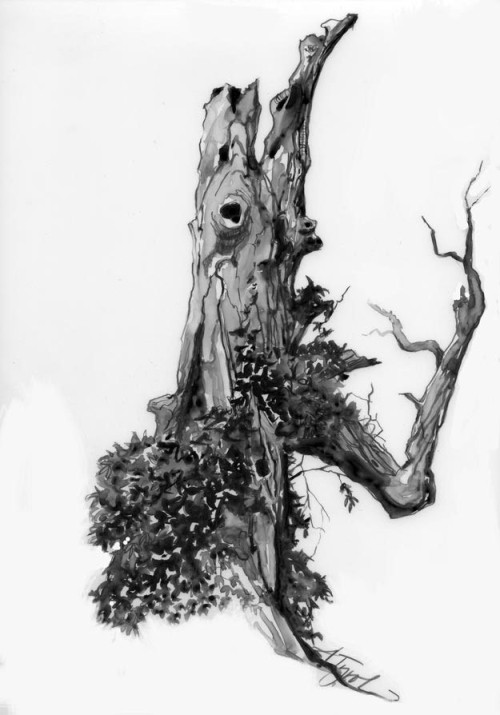
When we bought the old farm two decades ago, the Ghost Tree came with it. He was an old sugar maple with a knothole face, tears in the trunk and branch stubs. He looks like one of the Ents, the walking trees in the Lord of the Rings movies.
The Ghost Tree stands at the edge of an old pasture, inside a stone wall. Both sides of the road and driveway and adjacent stone walls were once lined with his kin, probably planted at the same time in the decades before the Civil War. It must have looked impressive. Today, fewer than a dozen of these mighty maples are left. Every few years we have to turn one into firewood.
We decided early on to leave the Ghost Tree alone. Massive as he was, there wasn't a heck of a lot of good firewood there. He didn't pose a danger to buildings or utility lines. His hollow trunk was home to many creatures.And he was beautiful, despite the decay.
There are lessons here in impermanence and equanimity; also, a firsthand look at how trees decay. Kevin Smith, a scientist with the US Forest Service's Northern Research Station in Durham, New Hampshire, told me that it can take a huge sugar maple like the Ghost Tree 60 to 80 years to decompose, from the time it really starts to go downhill until it's a pile of humus.
Smith was a student of Alex Shigo, an eminent forest pathologist who developed the “expanded concept” of tree decay: that trees react to injury and decay by walling it off, or compartmentalizing it. Humans repair injuries: bones knit, cuts heal, skin regrows. Trees, faced with a broken branch or a scrape, use chemicals to wall off the injury. Then the tree's outer living tissues grow around it.
While the forest often seems peaceful and quiet to us, it can be less idyllic for a tree. High winds, ice storms, gnawing animals, woodpeckers, insects, people with heavy machinery. Rare indeed is the tree that doesn't start collecting injuries as a sapling.
Some species, like aspens and birch, are poor compartmentalizers and thus don't tend to live very long. Others, like sugar maples, osage oranges, and giant sequoias “invest a lot in chemicals to resist decay,” said Smith. “But part of the beauty of nature is that eventually some fungus or a group of fungi will be able to break the defenses down.”
An unseen cloud of micro-organisms and fungal spores swirls around every tree in the forest, waiting for their moment. First on the scene of a wound are non-decay organisms hungry for sugars in exposed sap. They're followed by bacteria and wood decay fungi armed with special enzymes to break down cell walls to get at the locked-up carbohydrates.
Decay can involve many types of microorganisms. Some work at the same time, some follow one another. Some are specific to particular species, others are generalists. They're often aided by insects, animals, or birds.At some point, the tree can't summon enough energy to take care of the living tissues it's responsible for, and an inexorable decline begins.
The Ghost Tree has definitely deteriorated in the 20 years since we became part of the scenery.When we first made his acquaintance he had no top, but did have a couple of living limbs – each perhaps 18 inches or more through – that jutted out from the trunk then up, and looked like arms. Combined with his “face,”he looked like he was perpetually startled by something he saw coming down the road.
One arm dropped off a few years ago and the other is now dead. More of the top part of his massive trunk has disappeared. He is only a shell of his former self. The only green he wears is a toga of Virginia creeper.
He’s no longer a living tree since he has no leaves to process sunlight into energy. But he's alive in another sense, Smith told me. “If you count all the fungi, bacteria, and insects, and birds, and whatever else uses a dead standing snag, you’ll find that there's more life associated with a dead tree than there is with a sound, healthy, living tree.”

